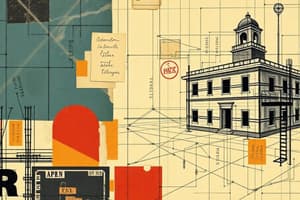Podcast
Questions and Answers
What do most symbol lists include?
What do most symbol lists include?
- Symbols for international projects
- Only those symbols applicable to the particular project
- All possible electrical symbols
- Symbols for both electrical and mechanical systems (correct)
What does the abbreviation AFF mean?
What does the abbreviation AFF mean?
- Above finished floor (correct)
- After final finish
- As found formerly
- Attach front first
When used as a grounding electrode, a ground ring must be at least how long?
When used as a grounding electrode, a ground ring must be at least how long?
- 20' (6.0 m) long (correct)
- 5' (1.5 m) long
- 15' (4.5 m) long
- 10' (3.0 m) long
When a screw is used as a main bonding jumper, it must be colored?
When a screw is used as a main bonding jumper, it must be colored?
What material must the main bonding jumper (MBJ) be made of?
What material must the main bonding jumper (MBJ) be made of?
What information is typically found in the title block of a construction drawing?
What information is typically found in the title block of a construction drawing?
Where is the legend block typically located on a construction drawing?
Where is the legend block typically located on a construction drawing?
Which block on a drawing contains the initials of the drafter, design supervisor, owner, and architect?
Which block on a drawing contains the initials of the drafter, design supervisor, owner, and architect?
What is the purpose of contour lines on a site plan?
What is the purpose of contour lines on a site plan?
Which of the following is a primary advantage of using an architect’s scale over an engineer’s scale in construction drawings?
Which of the following is a primary advantage of using an architect’s scale over an engineer’s scale in construction drawings?
Why is having 12 different scales on a triangular architect’s scale beneficial?
Why is having 12 different scales on a triangular architect’s scale beneficial?
What is the purpose of a key plan in electrical drawings?
What is the purpose of a key plan in electrical drawings?
Which of the following symbols indicates a range receptacle?
Which of the following symbols indicates a range receptacle?
Flashcards
Title Block Information
Title Block Information
The title block on a construction drawing contains essential information like project name, location, and possibly the owner.
Legend Block Location
Legend Block Location
The legend block, containing symbols and their meanings, is typically found in the lower right corner of a construction drawing.
Drawing Approval Block
Drawing Approval Block
The approval block contains the initials of individuals involved in the project, like drafters, supervisors, owner, and architects.
Contour Lines on Site Plan
Contour Lines on Site Plan
Signup and view all the flashcards
Architect's Scale Advantage
Architect's Scale Advantage
Signup and view all the flashcards
Key Plan's Purpose(Electrical)
Key Plan's Purpose(Electrical)
Signup and view all the flashcards
Range Receptacle Symbol
Range Receptacle Symbol
Signup and view all the flashcards
Number of Architect's Scale Benefits
Number of Architect's Scale Benefits
Signup and view all the flashcards
Ground Ring Length
Ground Ring Length
Signup and view all the flashcards
MBJ Material
MBJ Material
Signup and view all the flashcards
Screw as MBJ Color
Screw as MBJ Color
Signup and view all the flashcards
AFF Meaning
AFF Meaning
Signup and view all the flashcards
Symbol List Content
Symbol List Content
Signup and view all the flashcards
Study Notes
Construction Drawings
- Title block typically includes project name, location, and owner.
- Legend block usually located near the title block.
- Initials of drafter, design supervisor, owner, and architect are in the title block.
- Contour lines on site plans indicate property slope.
- Architect's scales are advantageous for detailed architectural drawings.
- Architect's scales can be more accurate for larger projects.
- Architect scales typically have 12 different scales which is advantageous for different projects and scales.
- 12 different scales on a triangular architect's scale allows for versatility and different scales for different projects.
Electrical Drawings
- Key plan identifies the part of a project to which the sheet applies.
- A circle with a single line crossing it indicates a range receptacle.
- Symbol lists include symbols for a particular project (not all possible ones).
- AFF stands for above finished floor.
- Ground ring must be at least 5' (1.5 m) long for grounding electrode use.
- A main bonding jumper (MBJ) must be made of copper or other corrosion resistant metal.
- Purpose of bonding jumpers is to connect to the service equipment to the utility supply.
Drawing Number Block
- Drawing numbers are typically located within a box in the architect's title block.
- Formatted as a letter and a dash (or two letters) followed by one to three numbers.
- First letter indicates the discipline.
- Second letter (if used) indicates subdivisions within discipline.
- First number usually relates to the sheet type/floor number of building.
- Subsequent numbers are usually sequential, sometimes skipped; allows changes or additions later.
Title Block (2 of 3)
- Title block is usually located in the lower right corner of the sheet.
- Information typically includes project name, location, owner, architect's firm, and job number.
- Includes the scale of the drawing and sheet number.
Scale Drawings
- To use a scale drawing, note the dimension on the drawing and convert it to the value of the scale.
- For example, if a drawing shows a scale of 1/2" = 1'-0", this means that every inch on the drawing represents two feet, so a drawing distance of 3" represents an actual dimension of 6'.
- Architect's scale has special markings and multiple scales to simplify drawing dimensions.
- A one-inch architect's scale can have a scale of 1" = 1'.
- Flat and triangular architect's scales are available.
- Triangular architect's scales can be marked with 12 different scales on each edge.
Load Center Sizing
- Each ungrounded conductor must have overcurrent protection (fuses or circuit breakers).
- Fuses and circuit breakers protect conductors and equipment.
- Ground fault circuit interrupters (GFCIs) protect people.
- A two-pole GFCI monitors the balance between two hot conductors and the neutral conductor.
- Any imbalance above 4mA will trip the device.
Grounding Electrode Installations
- Rod, pipe, and plate electrodes must be buried below the permanent moisture level.
- Free of nonconductive coatings (paint, enamel).
- Pipe can be driven at an angle if necessary to reach the required depth.
- Minimum depth is 8 feet vertically.
Studying That Suits You
Use AI to generate personalized quizzes and flashcards to suit your learning preferences.




